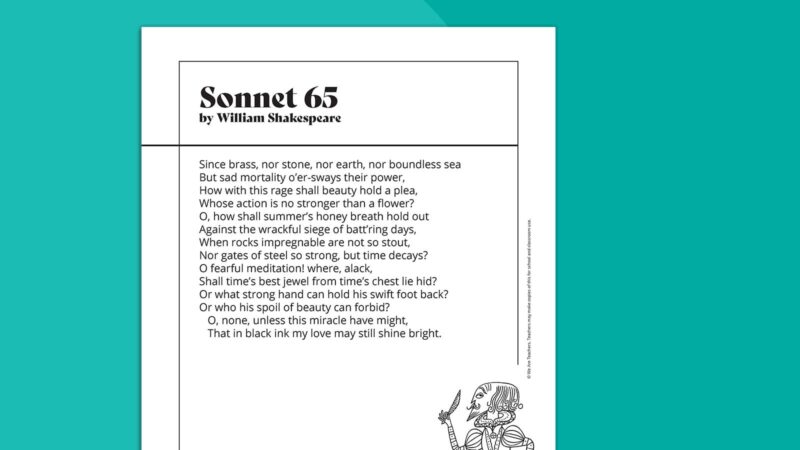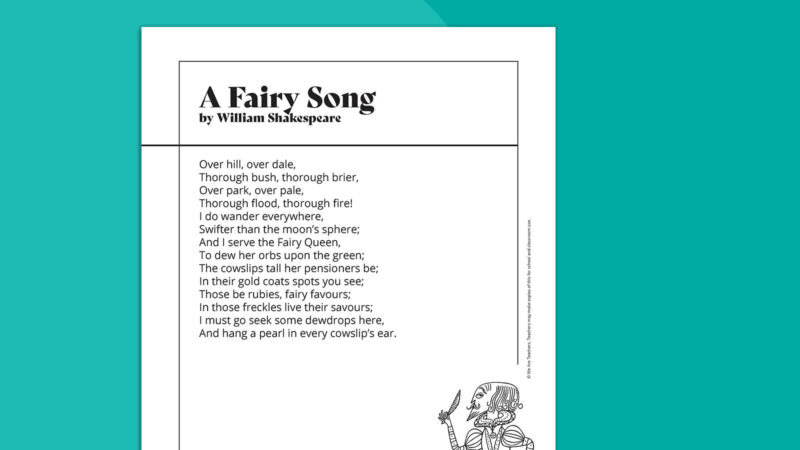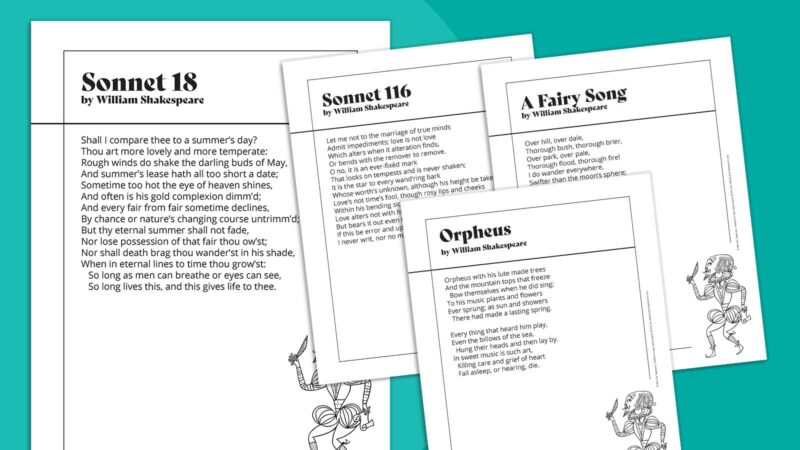William Shakespeare, who lived from 1564 to 1616, is widely considered to be the greatest writer in the English language. He was extremely prolific, having written 38 plays and over 150 sonnets. While Shakespeare wrote a handful of poems that weren’t sonnets, most of his poetry does fall into the sonnet category. Sonnets are 14-line poems that contain four quatrains of four lines each and a final couplet of two lines at the end. Here are some of our favorite Shakespeare poems to share with your students.
Be sure to fill out the form on this page to get the full text of each poem as a free printable to use with your students!
Sonnet 18
Shall I compare thee to a summer’s day?
Thou art more lovely and more temperate:
Rough winds do shake the darling buds of May,
And summer’s lease hath all too short a date. …
When people think of Shakespeare poems, this one likely comes to mind. The theme of this poem is immortality. In this sonnet, Shakespeare seeks to explain how love and beauty can be made immortal through the poem itself. The final lines exemplify this message, explaining that as long as people breathe and see, the poem will survive and thus give life to the subject of the poem.
Venus and Adonis
Even as the sun with purple-colour’d face
Had ta’en his last leave of the weeping morn,
Rose-cheek’d Adonis tried him to the chase;
Hunting he lov’d, but love he laugh’d to scorn. …
This very lengthy poem is considered pastoral since it has many detailed descriptions of nature. Another central theme is that of love and lust as the poem focuses on the unrequited love that the Goddess Venus has for the human Adonis. As with other Shakespeare works, the story ends in tragedy.
Sonnet 116

Let me not to the marriage of true minds
Admit impediments; love is not love
Which alters when it alteration finds,
Or bends with the remover to remove.
This sonnet attempts to define love by both describing what it is and also what it isn’t. The speaker ends the couplet with a statement of certainty saying that if love is not as he has defined it, then he has never written a word and no man has ever been in love.
All the World’s a Stage
All the world’s a stage,
And all the men and women merely players. …
This poem/speech is from Shakespeare’s play As You Like It. It is an extended metaphor, with the speaker, the character Jaques, comparing the world to a stage and all of the humans in the world to actors. The poem details the seven stages of life from birth through death. Each person, in their own way, is performing a different role throughout their lifetime depending on the situation.
Sonnet 130
My mistress’ eyes are nothing like the sun;
Coral is far more red than her lips’ red;
If snow be white, why then her breasts are dun;
If hairs be wires, black wires grow on her head.
This sonnet is an inverted love poem since the speaker compares his lover to many beautiful things, but always in an unflattering manner. While the speaker does find his lover beautiful, he is resisting the poetic trope of exaggerating a woman’s beauty through similes. While a traditional love poem might say that a woman’s lips were as red as a rose, here the speaker says “coral is far more red than her lips’ red.” The speaker makes clear that although his lover is not perfect, his love for her is just that.
Sonnet 43
When most I wink, then do mine eyes best see,
For all the day they view things unrespected;
But when I sleep, in dreams they look on thee,
And darkly bright are bright in dark directed.
In this sonnet, the speaker proclaims that he sees best when his eyes are closed. “When most I wink, then do mine eyes best see.” The speaker is, of course, referencing sleep and therefore a common theme in Shakespeare poems: dreams. While paradoxical, the speaker sees best at night with his eyes closed as he dreams of his beloved.
Sonnet 73
That time of year thou mayst in me behold
When yellow leaves, or none, or few, do hang
Upon those boughs which shake against the cold …
The theme of this sonnet is aging. Throughout the poem, the speaker speaks of death as a natural life process, employing nature imagery. He uses three metaphors throughout, the subjects of which are age, death, and love. He compares himself in the beginning of the poem to a tree in fall that contains few or no leaves anymore.
Sonnet 29

When, in disgrace with fortune and men’s eyes,
I all alone beweep my outcast state,
And trouble deaf heaven with my bootless cries,
And look upon myself and curse my fate …
This sonnet focuses on the themes of love, wealth, and loneliness. The poem begins with the speaker feeling isolated and less-than as he describes himself “desiring this man’s art and that man’s scope.” However, by the end of the poem, the speaker realizes that thinking of his lover brings him great happiness and wealth. This message is brought home by the final lines of the poem, “For thy sweet love remembered such wealth brings / That then I scorn to change my state with kings.”
Orpheus
Every thing that heard him play,
Even the billows of the sea,
Hung their heads and then lay by.
This poem is about Orpheus, who was a poet, musician, and seer in Greek mythology. Shakespeare writes of how Orpheus’ music was so powerful, it was able to bend elements of nature and even bring about “a lasting spring.” Shakespeare employs personification in his descriptions of the mountains and the sea.
Hark! Hark! The Lark
To ope their golden eyes;
With every thing that pretty is,
My lady sweet, arise:
Arise, arise.
As with many Shakespeare poems, there is both pastoral language as well as personification found in this relatively short poem. It also features a rhyming pattern of ABAB where every other line ends with a rhyming word.
The Rape of Lucrece
Her lily hand her rosy cheek lies under,
Cozening the pillow of a lawful kiss;
Who, therefore angry, seems to part in sunder …
This poem is one of Shakespeare’s earliest works. It is a tragic narrative poem filled with metaphors and imagery. The poem centers on Lucretia, a heroine of Ancient Rome. It tells the story of a terrible thing that happened to her at the hands of Tarquin, including how it happened and, finally, the tragic ending.
The Phoenix and the Turtle

Let the bird of loudest lay
On the sole Arabian tree
Herald sad and trumpet be,
To whose sound chaste wings obey.
This allegorical poem centers on the love between two birds, in this case the mythical Phoenix and a turtledove. The poem describes their death before proceeding to talk about the way in which their love unites them into one being while maintaining their individuality. The final section of the poem describes the way in which reason fails to understand how two can become one. The idea of true love transcending worldly reason was a common theme during the Renaissance.
Sonnet 138
When my love swears that she is made of truth,
I do believe her, though I know she lies,
That she might think me some untutored youth,
Unlearnèd in the world’s false subtleties.
The theme of this poem is truthfulness, as it centers around a relationship between two lovers who lie to each other frequently. It begins with a paradox as the speaker says in the opening two lines that while his love “swears that she is made of truth,” he both believes her and knows she lies. Rather than taking solace in their love, the speaker and his lover, instead, take comfort in the lies they tell each other.
Sonnet 19
Devouring Time, blunt thou the lion’s paws,
And make the earth devour her own sweet brood;
Pluck the keen teeth from the fierce tiger’s jaws,
And burn the long-liv’d Phoenix in her blood …
As with other Shakespeare poems, this one explores the ways in which poetry can prove eternal, transcending time. Shakespeare uses animal imagery throughout to highlight the natural effects of time and aging. He ends the poem asserting that his love shall live forever young through his verse.
Sonnet 106
When in the chronicle of wasted time
I see descriptions of the fairest wights,
And beauty making beautiful old rhyme …
This sonnet is part of the series of Shakespeare poems known as the Fair Youth sequence. This one, like the others in the series, is addressed to a young man. In it, Shakespeare travels through antiquity, where poets and others have tried to capture immeasurable beauty. He comes to the conclusion that the young man at the center of the sonnet possesses just that type of beauty that is therefore eternal.
Sonnet 55
Not marble nor the gilded monuments
Of princes shall outlive this powerful rhyme …
As with so many other poems on our list, Shakespeare uses this sonnet to explore the themes of time and immortality. While worldly things like statues will eventually crumble and go away, the poem will keep the memory of his lover alive forever.
Sonnet 20
A woman’s face with nature’s own hand painted
Hast thou, the master-mistress of my passion;
A woman’s gentle heart, but not acquainted
With shifting change as is false women’s fashion …
This is another sonnet addressed to a young man who is seemingly in an intimate relationship with the speaker. The theme of the poem is beauty and love with male and female traits described vividly and contrasted with each other. The poet suggests that the young man was initially intended to be a woman but nature decided to create him as a man.
Sonnet 65

Since brass, nor stone, nor earth, nor boundless sea
But sad mortality o’er-sways their power,
How with this rage shall beauty hold a plea,
Whose action is no stronger than a flower?
This is another poem that features themes of time and aging, beauty, and the ability of poetry to transcend time and become immortal. Throughout the poem, the speaker lists all the earthly things that will inevitably be destroyed by time despite their strength. He concludes that the love within his poetry can survive and “still shine bright.”
Sonnet 1
From fairest creatures we desire increase,
That thereby beauty’s rose might never die,
But as the riper should by time decease,
His tender heir might bear his memory. …
This is the first of Shakespeare’s sonnets and, like so many others, it deals with the theme of the passing of time and is addressed to a young man. It also uses pastoral language and descriptions to describe the beauty of the young man. The poem begins talking about the beauty of a rose never dying but ends speaking about the grave.
Sonnet 129
A bliss in proof and proved, a very woe;
Before, a joy proposed; behind, a dream.
All this the world well knows; yet none knows well
To shun the heaven that leads men to this hell.
This poem deals with themes of lust, pleasure, and shame. In it, the speaker says that while giving in to lust might be pleasurable, it will prove shameful. He says, “Enjoyed no sooner but despised straight.” He reiterates this point in the final line of the poem saying, “To shun the heaven that leads men to this hell.”
Sonnet 95
How sweet and lovely dost thou make the shame
Which, like a canker in the fragrant rose,
Doth spot the beauty of thy budding name!
This is another Shakespeare poem that is part of the Fair Youth sequence. As he often does, Shakespeare likens the beauty of the young man at the center of the poem to a flower. The speaker says that the youth’s beauty is so profound that it obscures a darker corrupt side.
Song: Fear No More the Heat o’ the Sun
Fear no more the heat o’ the sun,
Nor the furious winter’s rages;
Thou thy worldly task hast done,
Home art gone, and ta’en thy wages:
Golden lads and girls all must,
As chimney-sweepers, come to dust.
This verse is taken from Shakespeare’s play Cymbeline, where it is sung over the supposedly dead bodies of the characters Cloten and Fidele. The song/poem is about death and puts forth that you no longer need to fear the bad things in life once you are dead.
Song: Blow, Blow, Thou Winter Wind
Blow, blow, thou winter wind,
Thou art not so unkind
As man’s ingratitude;
Thy tooth is not so keen,
Because thou art not seen …
Like the poem “All the World’s a Stage,” this song appears in Shakespeare’s play As You Like It. The character of Amiens sings the song, which focuses on human flaws, especially ingratitude. He compares different harsh elements of nature, such as winter wind, to ungratefulness. The song ends with a paradox since the final line sung is “this life is most jolly,” which contrasts sharply with the overall negative tone of the song.
A Fairy Song

I do wander everywhere,
Swifter than the moon’s sphere;
And I serve the Fairy Queen,
To dew her orbs upon the green …
This song is from one of Shakespeare’s most beloved plays, A Midsummer Night’s Dream. The song describes the work of a fairy who is persisting despite difficult conditions like floods and fire. The fairy at the center of the poem works for the Fairy Queen Titania. As with other Shakespeare poems, he utilizes personification, describing flowers with human traits like freckles.
Sonnet 103
Alack, what poverty my Muse brings forth,
That having such a scope to show her pride,
The argument all bare is of more worth
Than when it hath my added praise beside!
In this sonnet, which is again addressed to the youth, the speaker laments that no matter what he writes, it will always pale in comparison to his muse. This sentiment is actually in contrast to many of his other sonnets where he claims that his writing is able to transcend time to achieve immortality and preserve the beauty of the youth.
Get free printables of all the poems

Just share your email address for instant access to full-text printable versions of all the William Shakespeare poems on this list.

